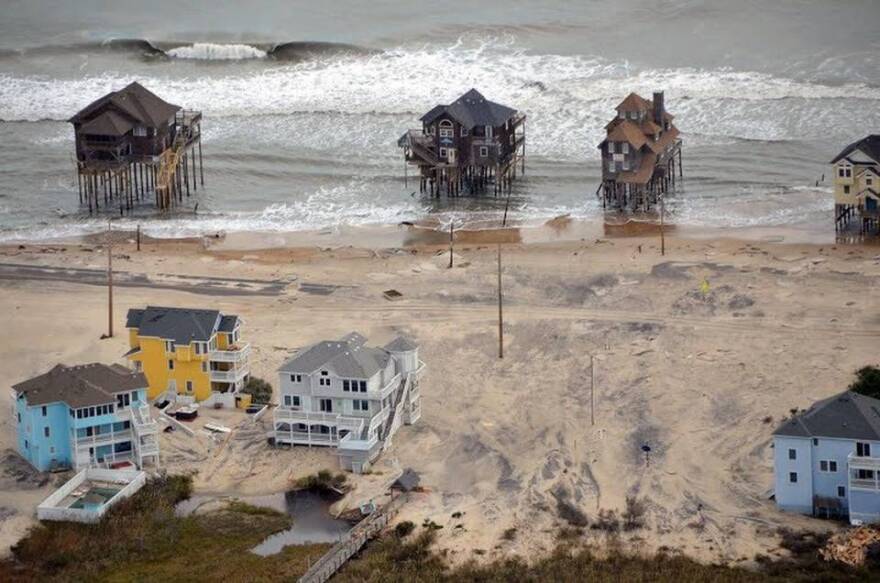As you stroll out toward the end of the Rodanthe Fishing Pier, it is impossible not to notice that itŌĆÖs not entirely straight.
It goes a little bit up. It goes a little bit down. The pier jogs a little to the right and left in different places. A few boards are loose, too, and itŌĆÖs mighty windy. In other words, itŌĆÖs not perfect, but for Terry Plumblee, being here is a lifelong dream come true.
ŌĆ£I grew up fishing on piers in the southern coast around Atlantic Beach, Morehead, Emerald Isle, and that, in the '60s and '70s and started fishing up here when I got out of college,ŌĆØ says Plumblee. ŌĆ£And I kind of always wanted to own a fishing pier.ŌĆØ
Plumblee is a retired Naval engineer. He and three partners bought the Rodanthe Fishing Pier out of foreclosure four years ago. It was in pretty rough shape, so they rebuilt it, freshened up the paint color, expanded into souvenirs and T-shirts, got rid of the pool tables that drew the wrong crowd and re-opened for business.
It went great for a while, until February of this year, when a NorŌĆÖeaster tore down the coast and tore off 80 feet from the end of the pier.
ŌĆ£We had about a hundred feet of beach in front of the pier house last year,ŌĆØ explains Plumblee. ŌĆ£So this winter, all this beach erosion has got the water to where itŌĆÖs under the pier house, like you see.ŌĆØ
(video courtesy )
The owners had enough saved to rebuild the pier and a also helped, but they canŌĆÖt put the beach back. That puts the Rodanthe Pier at a severe risk for more storm damage.
For those who do not live on the coast, names like Hazel, Fran, Irene and Sandy might sound like the champion shuffleboard team at the local senior center. But for those who live on the Outer Banks, they are the names of storms over the years that, often enough, destroyed their homes and businesses.
And according to scientists, it is only going to get worse.
ŌĆ£What was an event you could expect every thousand years youŌĆÖre going to get every century, if this comes to pass,ŌĆØ says Kerry Emanuel, a professor of meteorology at MIT and one of the worldŌĆÖs leading climate scientists. ŌĆ£And the 110-year event becomes a 20-year event.ŌĆØ
The theory is that the increase in devastating storms is due to the growing difference in temperature between the oceans and the atmosphere.
Along the coast, a few miles in how a storm tracks can mean the difference between a forgettable event and a catastrophe. If a hurricane comes from the ocean side, wind can damage homes and cut new inlets. But itŌĆÖs the sound side storms that are the real problem in many places, and one that could get much worse ŌĆō especially given the recent that predicted sea levels will rise between two-and-11 inches or so in North Carolina over the next 30 years.
ŌĆ£If you couple the high-category events with increased sea level you are really starting to come up with very strong risks of storm surges, which are like tsunamis, and in practice do a lot of the damage in hurricanes,ŌĆØ says Emanuel.

North Carolina has had a lot of practice dealing with the damage from hurricanes. State and federal governments have spent many billions of dollars rebuilding homes, businesses, roads and beaches.
And the state has strict rules for how close houses can be built along beaches and sounds, and how high they need to be.
But those rules may not be enough.
ŌĆ£We focus our money on lifting structures up but we donŌĆÖt get anybody out of the way,ŌĆØ says Rob Young, the director of the at Western Carolina University. ŌĆ£Whose job is it to underwrite the risk of making the choice to invest those dollars on the oceanfront? And right now, essentially the federal government is absorbing all the risk for that decision.ŌĆØ
Young says it is bad fiscal policy to constantly rebuild after storms, especially if those storms are increasing and more people are building investment properties and hotels on the beach.
At some point, he says, dealing with storms will have to involve ŌĆ£managed retreat.ŌĆØ
ŌĆ£And managed retreat doesnŌĆÖt mean abandoning the shorelines,ŌĆØ he explains. ŌĆ£It doesnŌĆÖt mean running in there, sending in the stormtroopers and telling everyone to leave. What it does mean is that when you have a storm like Hurricane Sandy, we shouldnŌĆÖt put everything back in place exactly where it was using public funds.ŌĆØ
That kind of talk, no matter how reasoned it may sound to some people inland, is summarily dismissed by those who trace their roots back a century or more on the Outer Banks.
ŌĆ£You got a community that has heritage here,ŌĆØ says Willo Kelly, the government affairs director for the .
ŌĆ£YouŌĆÖve got people that their grandparents, their great-grandparents lived here. And youŌĆÖre just not going to tell them, ŌĆśweŌĆÖre sorry, this isnŌĆÖt the best place for you to live anymore. You just need to move. Just move to the mainland and there will always be a shoreline, it will just be in a different place and you donŌĆÖt need to be fishing. WeŌĆÖll just get that fish from Thailand. We just want to keep this the way it is.ŌĆÖŌĆØ

But not everyone has been on the Outer Banks for generations or owns a multi-million dollar investment property. For some, like Terry Plumblee at the Rodanthe Pier, itŌĆÖs about a simple business, and a simple life.
ŌĆ£Well, IŌĆÖd love to do this as long as IŌĆÖm physically able to fish,ŌĆØ he says. ŌĆ£That was really the calling for me. I like to come down here and fish.ŌĆØ
As Plumblee talks, the surf smashes into the pilings holding up the pier house. The vibrations come up through the floor of the building and rattle the plastic chairs weŌĆÖre sitting in.
That 100 yards of beach he thought he bought four years ago is gone and the waves are already threatening his brand-new parking lot behind the building.
And this is a relatively calm day.
When asked about the scientific predictions that 100-year storms could happen every decadeŌĆöand could eventually send his pier into the oceanŌĆöPlumblee shrugs.
ŌĆ£I donŌĆÖt pay a lot of attention to it, to be honest with you,ŌĆØ he says.
ŌĆ£It only takes one.ŌĆØ
Read Part 1 of The Changing Carolina Coast:
Read Part 2 of The Changing Carolina Coast:











